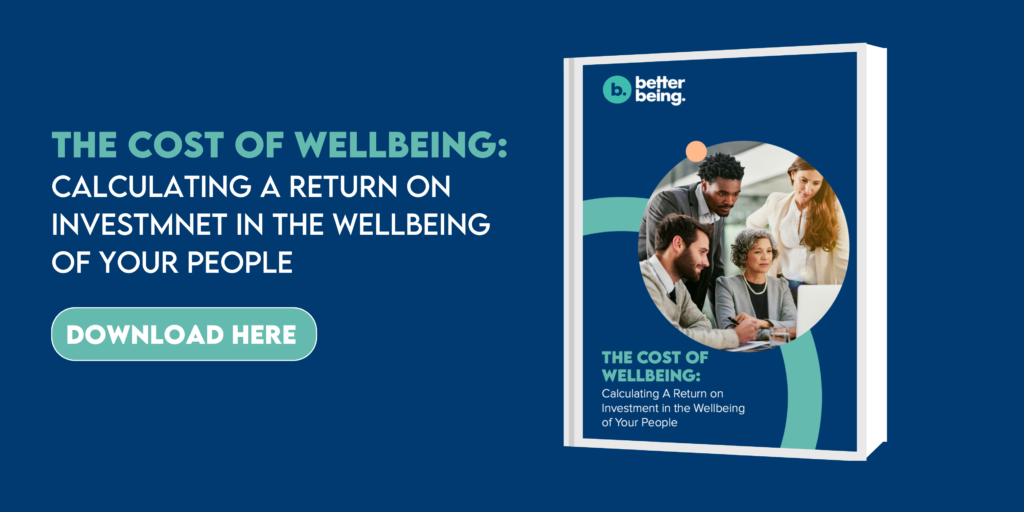Investing in an employee wellbeing program can yield significant benefits, not just for the workforce but for the entire organisation. However, to truly understand the impact, it’s crucial to measure the Return on Investment (ROI). This article will walk you through the steps to effectively measure the ROI of your wellbeing initiatives, with tools to help simplify this process.
Why Measuring Wellbeing Program ROI Matters
Understanding the ROI of your employee wellbeing program is essential for several reasons:
- Justify Investments: Demonstrating tangible benefits can help secure ongoing funding and support from stakeholders.
- Optimise Programs: Knowing what works and what doesn’t allows you to fine-tune your initiatives for maximum impact.
- Enhance Employee Engagement: Effective programs lead to happier, healthier employees, which in turn boosts productivity and retention.
Key Metrics to Track
1. Employee Health Metrics
Monitoring health metrics such as stress, sleep and social connection can provide clear indicators of your program’s effectiveness. Reduced absenteeism as a result of improved health and wellbeing often translate directly into financial savings. For more information on how to measure employee wellbeing, discover our Wellbeing Index.
2. Employee Engagement and Satisfaction
Engaged employees are more productive and less likely to leave. Use surveys and feedback tools to gauge changes in employee satisfaction and engagement levels before and after implementing your wellbeing program.
3. Productivity Levels
Increased productivity is a significant indicator of a successful wellbeing program. Track performance metrics and project completion rates to see if there’s a noticeable improvement.
Calculating the ROI
Step 1: Define Your Objectives
Start by clearly defining what you want to achieve with your wellbeing program. Are you aiming to reduce healthcare costs, improve employee retention, or boost productivity? Having specific goals will guide your ROI measurement process.
Step 2: Gather Baseline Data
Collect baseline data on the metrics mentioned above before implementing your wellbeing program. This will provide a point of comparison to measure your program’s impact.
Step 3: Implement the Program
Roll out your wellbeing initiatives, ensuring that they are aligned with the objectives you’ve set. This could include activities focused on movement, mindset, nutrition, and recovery.
Step 4: Track and Analyse Data
Regularly monitor the key metrics and compare them against your baseline data. Look for trends and patterns that indicate improvement.
Step 5: Calculate Financial Impact
Translate the improvements into financial terms. For instance, reduced absenteeism can be quantified by calculating the cost savings from fewer sick days.
Introducing the WellWise ROI Calculator
To simplify the process of measuring your wellbeing program ROI, we’ve developed the WellWise ROI Calculator. This tool provides:
- Comprehensive Analysis: Get detailed insights into workers’ compensation claims, turnover, absenteeism, and presenteeism across 17 industries.
- Customisable Inputs: Tailor the calculator to your industry and organisation size for precise results.
- Pre- and Post Intervention: Calculate the cost of poor employee wellbeing prior to wellbeing interventions and unveil cost savings post wellbeing intervention.
Practical Tips for Maximising ROI
Focus on High-Impact Areas
Identify the areas where your employees need the most support and tailor your programs accordingly. Whether it’s stress management, physical fitness, or nutrition, targeted efforts yield better results.
Encourage Participation
The success of any wellbeing program depends on employee participation. Foster a culture that values and encourages engagement in wellbeing activities. This can be achieved through regular communication, incentives, and leadership support.
Regularly Review and Adjust
Wellbeing needs can change over time. Conduct regular reviews of your program’s performance and be prepared to make adjustments based on feedback and data analysis.






